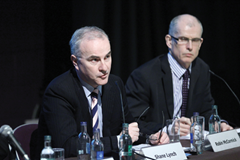The future: Shane Lynch
 Utility Regulator Shane Lynch discusses future energy network investments with Owen McQuade.
Utility Regulator Shane Lynch discusses future energy network investments with Owen McQuade.
Meeting the target of 40 per cent of electricity generated from electricity by 2020 will be very challenging, according to Shane Lynch. NIE has estimated that a £1 billion investment could be needed to reach the Strategic Energy Framework’s target, in addition to other investment requirements.
The Utility Regulator is required to approve any investment through a price control review, which is carried out every five years. The current review period ends on 31 March 2012 and the next will run to 2017.
“Up to now we’ve had four price controls since privatisation in 1992. [In] the first three and even the fourth price control, the current one, the capital that’s been invested in the network has largely been for what we call refurbishment of the network and for growth,” he explains.
“Growth to date has typically been just an increase in demand for electricity from increased consumption, new houses and factories being built. Our capital expenditure approval has all been based on those two things.”
From now on, capital expenditure will focus on integrating renewables and wind into the system. “Very little” of this has come through the current review period (RP4). The regulator must therefore ask: “Why should we approve that investment?”
Refurbishing the network is normally mandatory, for safety reasons, but consumers also want reliability and much of the capital expenditure is spent on keeping ‘customer minutes lost’ to a minimum.
Noting that the 40 per cent target is identified in DETI’s Strategic Energy Framework, he says that the framework “also talks about the high level of fuel poverty we have and that we should try to eradicate that.”
Looking at that, he states that the regulator’s principal statutory objective is to protect consumers, which comes before protecting vulnerable customers and the environment, and ensuring that licence holders can finance their activities.
“Energy policy is not prescriptive, it’s a framework, so we have to weigh it up and make decisions,” he notes. The regulator must ask what a network investment programme put forward by NIE will deliver.
“We would say well, first of all, 40 per cent is not mandatory and secondly it doesn’t all have to be about wind. At the minute, we’re at about 10 per cent with about 450MW of wind on the system. To get to 40 per cent, one option would be to connect about another 1,200MW of wind.”
Another option would equal 400MW of biomass, achieving the same result. In practice, a 150MW biomass total is more likely but could be considered equivalent to 450MW of wind.
In his view, 20 per cent renewables can be reached with some £100 million of investment. Getting to 40 per cent could require “very major investment” and the regulator will need to “think long and hard before we approve any investment, depending on how we achieve this.”
An incremental approach makes most sense to him, given the uncertainty.
“Let’s maybe get to 20 per cent with a fairly modest investment and let’s continue to evaluate all the options and promote all the options,” he says, “because it does strike me that doing it all in one is a very expensive solution. I think we should be promoting the other options.”
The recession, in an economy which “already has a pretty stretched budget”, and the high fuel poverty levels also bear heavily on his thinking. Forty per cent may therefore be very expensive. Increasing consumer engagement, and carrying that out sooner, will be a priority for review period five (RP5).
“The key thing for us as regulators is we, number one fully evaluate the options and number two make consumers fully aware in advance of what the choices are and what the cost-benefit [implications] of those are before we make the decisions,” he comments. “Because once we make the decisions and approve investment it’s too late. What we’ve found is that consumers tend to only intervene when the bill pops through the letterbox and then it’s too late.”
Network investment
Asked whether he is considering a different model for funding NIE’s network investment, he widens his answer out to all three utilities.
Lynch remarks: “Given the level of expenditure that’s needed here, not just in electricity but in all of our three utilities, and given that we’re in a constrained economy, we think it is incumbent on us to re-examine the various ways in which we can deliver those investments and also how we finance those investments.”
In the current model, the network owner effectively does everything i.e. developing, constructing, financing and operating the entire existing network “plus all the new build.” All activities are bundled together, finance is raised for the whole package and the operator receives a regulated cost of capital.
The Utility Regulator has commissioned First Economics to consider whether other options are possible, whether those activities should be unbundled and whether that would produce a better outcome for consumers.
Network operation is “largely a monopoly business and that doesn’t lend itself to competition.” However, he thinks competition should be possible in the network building process: “Why not look at the potential option of putting it out to tender who builds major chunks of new network and then it would be a build-in transfer? Potentially at the end of the project they would transfer the asset to NIE so that then NIE then becomes the single owner of the network.”
 He suggests that if the activities were unbundled and major infrastructure projects were put out as a separate competition, they could be built and financed at a lower cost.
He suggests that if the activities were unbundled and major infrastructure projects were put out as a separate competition, they could be built and financed at a lower cost.
“Constructing a project is seen as a higher risk than operating a project and the cost of capital is typically higher for construction than operating but at the minute those are all bundled together,” he notes. “In other words it comes down to contestability and we’ve started the debate: ‘Should we have contestability?’”
NIE is currently “incentivised to spend as much as possible because they have more capital earning return”. This also gives NIE an incentive is to build its regulated asset base.
Lynch accepts that NIE will say it has internal procurement policies and procedures, and puts everything out for competitive tender, but unless the regulatory regime is “entirely pass- through”, a regulator never gets to see that.
In 15 years, Northern Ireland’s natural gas network has been extended to Belfast and 10 towns across the province. “It costs a lot more to serve a customer in Belfast than it does to serve Ballylumford power station because the network is much longer to get to Belfast,” he comments, but consumers pay the same bills (and subsidise each other) through postalisation.
On a standalone basis, there are issues to consider about paying for extending gas to the west of Northern Ireland. This will include extending postalisation across Northern Ireland. Apart from postalisation, the extension could be funded by a grant, but that may be unlikely in these constrained times.
Market developments
The bigger picture in energy is “quite a dynamic situation at the minute”. Firstly, a new Irish Government has been elected. The McCarthy report may recommend the sale of state-owned assets, particularly non-network assets such as ESB power plants.
The EU’s third energy package (IME3) is the other dynamic and requires the unbundling of transmission networks.
“Those decisions have to be made in both jurisdictions to comply with the Directive and in both cases they are decisions for the two departments,” he explains. “We as regulators end up certifying that whatever happens is or isn’t compliant with the Directive. So you have those couple of dimensions that are at play simultaneously and it’ll be interesting to see where that all settles down and what the landscape looks like in a couple of years’ time.”
The regulators are now looking at where to take the Single Electricity Market (SEM), the next natural step being east- west regional integration. European regulations are pushing towards a single European market and the ability to trade electricity in real time across all of Europe.
In retail competition, the regulator is mindful of the experience elsewhere – in Great Britain and the Republic of Ireland. He is keen to ensure that the retail competition model in Northern Ireland best reflects local circumstances and derives learning from elsewhere.
“Our sense is we’re comfortable with that model as it is,” he comments. “Our reservation about removing regulation is that it’s a very small marketplace and therefore the ability to promote unfettered competition is limited by size.”
Ireland is a “hostage” to rising gas prices as these are linked to oil prices in Europe. However, the two are decoupled in the USA which means that gas is half as expensive as it is here. Phoenix’s tariff from 1 May will unfortunately reflect the impact of global crises such as the Middle East conflicts and the Japanese tsunami.
Future outlook
Looking across the three utilities, electricity is obviously the most advanced: “NIE’s costs have gone down; their services have gone up so the regulatory model in electricity is well proven to have delivered value.”
Gas is “on the right trajectory” but water is “at a very early stage”. Under direct rule, the utility was due to become a 100 per cent government-owned company in this Assembly mandate but he adds: “We’ve stopped really on our path, we’ve stood still and I think where we’re at is probably not the optimal place so we need to pick that up and decide where we’re going.
The economic principles and need for infrastructural investment are “very similar” across all three utilities.
“For all of it you do business in a political context,” Lynch says. “My sense is it’s a good idea to regulate more than one utility there’s just a lot of synergy there and economy of scale and building up expertise that apply across all three.”
Profile: Shane Lynch
Originally from Derry, Shane completed an undergraduate degree in mechanic engineering at Queen’s University Belfast, followed by a masters in finance and investment at the University of Ulster.
He has always worked in the electricity industry in Northern Ireland and held a series of engineering posts in NIE until it was privatised in 1992. Shane subsequently worked for the AES corporation as Managing Director of Belfast West (from 1998) and Kilroot power plants (from 2002), and was appointed as the firm’s Development Director in 2006.
Shane moved to the Utility Regulator as Director of Electricity in September 2009. He is married with three young children, aged five to 13.





